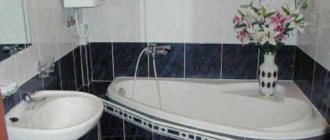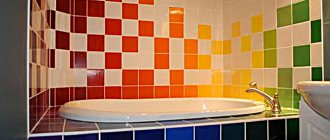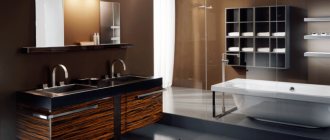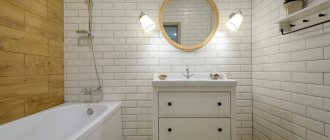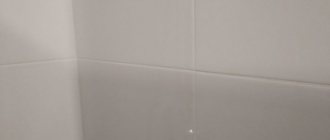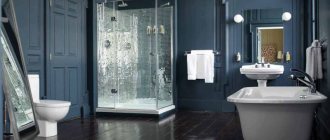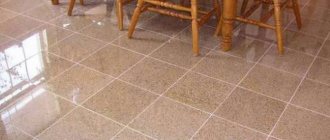No matter what new materials appear on the construction market, tiles are still considered traditional for bathroom design. It helps to form a finish that protects the floor and walls from moisture and steam, lasts quite a long time, and at the same time makes it quite easy to care for the finish of the described room. In order for the wall and floor cladding to be pleasing to the eye, you need to choose the right size of tiles for the bathroom. A lot depends on him. Therefore, it makes sense to make a brief overview of all existing options and outline the basic rules of choice.
Difficulties in decorating a bathroom
A sanitary room is a room in which daily hygiene procedures take place. The floor and wall in this room are constantly exposed to the same load, and tile materials can cope with it. Due to limited space, not all of their varieties can be used to decorate a bathroom. In order to understand what sizes of tiles are most optimal for the room being described, it is necessary to describe in detail the existing classification of tile coverings.
Rubber tiles for flooring
The product has noise-absorbing properties. It is not exposed to high temperatures, does not crack, does not get wet and does not fade. They produce tiles in various colors and patterns. With its help, you can change the interior appearance of your bathroom or bathroom for the better. It can be easily installed on the floor, walls and even the ceiling. Easier to install than any other material.
Also on the topic: How to remove silicone sealant: removing silicone from bathroom tiles
In addition to rubber coating, PVC tiles are used. These panels are also easy to mount on a surface. They wash well and look good. But PVC products do not have the same color range as the previous material. In addition, they are susceptible to mechanical damage. In case of inept installation, conditions for the development and spread of fungus can be created.
Bathroom wall tile sizes
Installation of vinyl cladding on walls does not require the use of moldings or other means. In addition, the use of this lightweight material ensures accessibility to technological communications. The surface of vinyl products is rough and does not slip like ceramics.
The main advantages of PVC panels:
- resistance to moisture;
- visually no different from ceramics;
- relative cheapness;
- painting like marble, wood, stone;
- environmentally friendly;
- The cladding looks decent and is resistant to moisture.
PVC tiles can be mounted on the floor, walls or ceiling using lathing. In the room, each wall will be reduced by 4 cm. The dimensions of bathroom tiles are most optimal at 15x15 cm. In most cases, ceramic products are considered the generally accepted standard. It is possible to create mosaic paintings from small tiles of 2.5x2.5 cm. But more often 33x33 cm or more are used. Any size looks good in a spacious bathroom. Small squares are placed in small rooms.
Ceramic is considered the standard cladding for walls, ceilings and floors. As a rule, dark colors are laid on the floor, and light tiles are used for the walls. The surface decorated with a patterned pattern looks good. And ceramics with a wood texture, designed to look like stone, marble are often placed on the floor, the lower part of the wall.
Products 10x10 cm are best suited for decorating bathrooms. Standard sizes of bathroom tiles range from 33x45, 30x60 cm.
Ceiling tiles
Covering the ceiling with PVC material should take into account the further installation of ventilation and lighting systems. Dimensions can be 30x30 cm. The thickness should not be chosen more than 7 mm. The panels are secured with self-tapping screws or dowels.
Classification by size
Experts distinguish four classes of tiles:
- Mosaic – tiles, the modules of which have sizes from 1x1 to 5x5.
- Small tiles (square bathroom tiles 20x20 cm, 15x15 cm or rectangular tiles 20x30cm).
- Medium tile (square dimensions 20x20 cm and rectangular tiles, one side no more than 40 cm).
- Large tiles are those with one side larger than 40 cm (30x60, 25x50, for example).
The most popular tiles are 15x15 cm or 20x30 cm. Until recently, all tile material was presented in similar sizes. Today, new samples have appeared; designers willingly use non-standard sizes of tiles for the bathroom, giving preference to wall cladding with rectangular modules, one side of which is half as long as the other (15x30, 25x50 or 20x40, for example).
When choosing bathroom tile sizes, it is important to consider the scope of its application. To decorate the floor, experts say, it is better to use square tiles, rectangular tiles measuring 20x30, 25x50. It is better to use 15x30 tiles on the floor as additional decorative inserts.
There are minimum (20x30 cm) and maximum sizes of floor tiles. Until recently, when choosing the largest format tile, you could expect to find modules whose width increased by 60 cm. Today, ceramic floor tiles for a bathroom can have dimensions of 150x150 cm.
When choosing tiles, it is important to pay attention not only to the length and width of the module (it is necessarily indicated in the product labeling in the form of numerical designations 20x30, for example). But also take into account the thickness of the tiles. It is this parameter that can indicate the scope of use of the modules. If the tile has a thickness of 6 mm, this material should be used for wall cladding. Bathroom floor tiles 25 cm wide and long should have a thickness of 9-12 mm. The higher the pedestrian load in the room, the thicker the modules used for floor covering should be.
Cross size for tiles
The parameters and dimensions of floor tiles are one of the main criteria when choosing a material.
The difficulty of choosing lies in the fact that at the moment specialized stores provide not only slabs with a standard look, but also original shapes that can surprise the buyer. Sometimes these shapes can be combined, and thus allow you to create a unique pattern or pattern for the floor covering. It happens that the owner prefers simplicity, in which case the width prevails over the length, or simply larger slabs are purchased. But the most important thing here is to determine the standard size of the slabs that are most often used in private households - this is 300x300 mm.
It is better to select the size of floor tiles taking into account the interior of the room
There are 8 sections in which the main dimensions of the slabs are indicated, these are:
- 200-200, 100-100, 250-250, 150-150 mm, these sizes correspond to square fragments;
- 100-200, 300-400, 150-300 mm such sizes are classified as rectangular shapes;
- 114-200, 98-170 mm these dimensions refer to pentagonal slabs;
- 150-174, 200-230, 170-196 mm are the sizes of hexagonal shapes;
- 68-98, 83-117, 97-139 mm such dimensions are typical for triangular shapes;
- The sizes of non-standard tetrahedral tiles will be: 76-173, 85-195, 100-230 mm;
- Octagonal elements have the following parameters: 70-100-200, 60-85-170;
In order to choose the right tiles for flooring, you need to take into account the square footage of the room and especially the open part, which is intended for flooring. In order to obtain the optimal design and visual expansion of the room, it is necessary to select the most suitable cladding scheme, and carefully consider the correspondence of fragments of different shapes.
When created, tile slabs can be adjusted to a certain size. The format of each tile has a certain difference. In addition to the fact that their height and width are different, their thickness also has different indicators, and this point is important. If we talk about floor tiles, they will always be thicker than other models, since this particular option is susceptible to high mechanical loads, it can reach up to 14 mm, while wall slabs are equipped with a thickness of no more than 9 mm. These indicators depend on the type of tile.
You can get acquainted with the different sizes of tiles yourself in specialized stores.
It is important to pay attention to the fact that, if desired, ceramic floor tiles can be placed on the wall, but wall tiles should never be placed on the floor, since under heavy load they can crack and cause injury. The optimal size of ceramic tiles for floor finishing is 300x300 mm.
There are also a number of other sizes of both floor and wall ceramic tiles, but the most optimal and frequently used sizes are the parameters given above. Different decorative fragments have individual properties; they differ in multiples and multiples of the basic tile format.
To select tiles for kitchen tiling, you need to take into account the small or large size of the tiles; for a bathroom or toilet, you need to choose the average size of tiles.
To cover a vertical surface, the principle of proportionality must be observed.
For wall cladding in a small room, it is best to select medium-sized ceramic tiles
In addition to all this, the position of the tiles on the wall is also important. If the ceiling in the room is disproportionately high in relation to the dimensions of the room, then horizontally glued rectangular tiles will visually reduce this disadvantage, but at the same time add length to the room. And if wall ceramics are laid vertically, the walls will visually rise, and the length of the walls will decrease with this method. This laying principle is used to adjust the dimensions of the floor if the tiles are rectangular in shape.
Before you go purchasing tiles for floors or walls, you need to understand that the size of the tile is not the most important thing, the first thing you need to pay attention to is your interest in its appearance, you should definitely like it. That is why designers recommend that you first choose a specific collection, and only then, after consultation, choose the optimal size. Remember that some collections already have several options for tile sizes, this greatly simplifies the task when purchasing.
There are three types of tiles according to the manufacturing method:
- cast - clay mass is poured into special molds;
- pressed – production under high pressure from a mixture of a powdery structure with additives;
We suggest you familiarize yourself with How to remove rust on a toilet
Pressed tiles
tiles made by extrusion - pressing through a certain shape.
Extruded tiles
Before choosing tiles, you need to decide on the size of the tiles that will be suitable for laying tiles in the bathroom.
- Ceramic tiles are rectangular or square shaped plates.
- The most common sizes in centimeters are as follows:
Ceramic tile sizes
- The thickness of the tiles can range from 8 to 20 millimeters.
How to choose the right tile, what kind of ceramic tile coating is there?
Ceramic tiles are:
- glazed (enameled);
- without enamel coating.
Enameled tiles
The colors of glazed tiles are quite varied; they also come with decorative patterns or simply one color.
Matte tiles cbvf
How to choose tiles for the floor, walls and ceiling in the bathroom? What do you need to know about heat treatment of tiles?
There are two categories:
- single firing;
- double firing.
- Single firing (monocoturra) - the glaze is applied to wet clay, then the tile is placed in the oven, as a result the base and glaze are fired simultaneously. When firing occurs, these two components are very tightly soldered to each other and the tile turns out to be quite durable.
- Double firing (bicoturra) - first the base is placed in the oven, then the glaze is applied. The tiles are then re-fired at a lower temperature, resulting in a smooth and shiny glaze with bright, rich colors.
- The number of firings is indicated on the packaging with a special symbol - a flame petal with a number drawn next to it.
Double and single fired tiles
A very important aspect, without working through which you can direct all your efforts down the drain, is the stylistic key underlying the interior. And if the owner of the living space is not a designer himself, then it is better to use ready-made solutions that have proven themselves in practice more than once. Of course, nothing prevents you from coming up with your own option, but it is better to discuss its details with a specialist.
A classic-style bathroom is a universal solution that does not lose its relevance over the years. As a rule, to implement such projects, light and dark tiles of a related palette are used, where the base is laid with darker tiles, and the top to the ceiling with light tiles. To differentiate, use a border, which usually contains a pattern of both colors used.
If the owner likes natural motifs, then using green, blue, beige and brown tiles you can create real oases in the apartment. Tiles of natural shades are used for complete wall cladding, including finished panels or laying out patterns from borders or mosaics. Of course, the greatest freedom of imagination is available to owners of large bathrooms; here you can implement a themed beach or aquarium design, dedicate the design to a specific culture, or convey tropical notes.
We invite you to familiarize yourself with Tiles for a Small Bathroom 150 PHOTOS
An oriental-style bathroom is a kind of hammam, which is always bright and original. This style can be realized today with the help of collections from tile manufacturers that use intricate motifs and ultra bright colors for design. And it can be supplemented with small mosaics laid on the facades and sides of furniture and plumbing fixtures.
This style is perfect for spacious rooms, if your bathroom is of modest size - the solution should be sought in less saturated colors and using a medium-sized pattern. A plain tile decorated with a border in Turkish cucumbers or birds, hieroglyphs or oriental mosaics looks good. To embody this style, it is best to use red, yellow, gold, green, blue and turquoise.
A mirror is a great addition to any bathroom, and if you want to be extra fancy, you can use mirror tiles on the surface of the bathroom walls. This will make it simply endless for your eyes, but will also add work to polishing and removing dried drops. Such tiles can be used as separate inclusions, and this is a successful solution to the problem of an irregularly shaped or small bathroom. If you place it on the ceiling, you will feel incredible spaciousness even in a small room.
Decorating a living space always starts with the bathrooms. This is labor-intensive and wasteful, noisy and the most expensive.
Having every reason to start renovating the bathroom, the user becomes a victim of countless views of fashion catalogs and visits to construction markets, long thoughts, tossing and doubts. And given the diversity offered by the modern market of finishing materials, the search for standard tiles and equipment may take much longer than originally planned.
The consumption of tiles depends on the shape of the ceramics
Selecting tile sizes depending on the size of the room
When decorating a bathroom, you cannot choose just any tile. The dimensions of the modules must correspond to the dimensions of the described room. Here are the main recommendations that you should definitely take into account when planning the design of your own bathroom.
- Mosaic tiles measuring 10x10 or 15x15 can only be laid in large areas.
- For bathtubs located in standard apartment buildings, the best solution can be wall tiles measuring 20x30 cm and floor tiles 30x30.
- Correctly placed tiles can visually change the boundaries of space. Long modules placed horizontally widen the walls and expand the floor. Vertical cladding with a vertical pattern visually raises the ceiling.
Note! If you choose large tiles for a small bathroom, there will be too much waste left after installation. They indicate that the material was used irrationally.
Application of foam plastic
Repair will not be a difficult process if you choose foam boards. As a rule, light colors are chosen for the ceiling. Or shades of blue, beige. White material is cheaper, but looks noble and fits into any interior. It is not placed on the floor or walls. This is explained by the high moisture absorption of polystyrene foam and its fragility. Ceramic granite slabs designed to look like stone are used as flooring and wall coverings. Decorative designs enhance the space.
Also on topic: How to choose tiles for a small bathroom: useful tips
The installation of foam tiles should be approached with extreme caution due to its fragility. The use of water-based paint will significantly increase resistance to moisture, which is always abundant in the bathroom. The thickness should not be chosen more than 7mm. It is important to remember that it is not advisable to wash or wipe foam products.
Which tile is suitable for the bathroom, sizes, pattern
Most often they use a mosaic texture, which is made in sheet form. Sizes from 30x30 cm and above. The mosaic pattern can be mirrored, made to look like artificial stone, marble, metal, glass. If tiles are chosen for the floor, then it is best to choose a non-slip material. We should not forget about the need for access to communications. For this purpose, bathroom hatches for tiles are used, the dimensions of which must correspond to the laid squares or rectangles.
Polymer sand tiles are most often used when laying sidewalks. Some people like this finish, or a similar one, as a bathroom decor. This type of cladding can be imitated using special painting.
You can also achieve an imitation of marble and granite. It is clear that natural stone is very expensive, but the same effect can be achieved by using ceramics with the desired pattern. Visually it looks rich and unusual.
It is not necessary for the cladding to have a cold marble shade. The light beige coating looks very good. It gives the bathroom coziness and warmth. Light colors are suitable for the ceiling. It may be bluish or white. In the case where the room area is small, the floor should be dark shades like artificial stone or marble.
When materials with imitation marble or artificial stone are used in decoration, the bathroom is transformed and takes on a stylish look. Standard sizes of bathroom tiles allow this to be done. A design solution will help not only in choosing sizes and colors, but also in the direction of installation. It can be changed relative to the walls. All this will add unusualness and originality to the bathroom.
Mosaic tiles 10x10
Mosaic is a cladding that is assembled from small modules of 10x10 size, for example. The modules are assembled into a square and held on a mesh base. This design significantly simplifies the installation process. But assembling a 10x10 mosaic on your own is not so easy. To install modules, it is necessary to use professional skills and abilities, so not everyone decides to reproduce this process independently with their own beeches.
Small format tiles 10x10 or 15x15 have their advantages:
- To install it, you do not need to carefully level the base first.
- Only such tiles can be laid on a curved base.
- Modules measuring 10x10 look quite impressive in the interior.
The disadvantages of using the described material are also obvious:
- The installation process is labor-intensive, only painstakingly done work will allow you to enjoy beautiful results.
- Grouting joints takes a lot of mastic.
- In order for the seams to look decorative, it is necessary to choose expensive white grout. And these are additional costs.
- Filling the seams of 10x10 tiles should be done as evenly as possible, otherwise the mosaic canvas will look sloppy. Without certain skills it is very difficult to do this.
- Due to the presence of a large number of seams, the mosaic surface quickly loses its hygroscopicity. Improper use of 10x10 cm tiles often leads to the formation of mold and mildew.
- It is difficult to care for small-format tiles; white seams quickly become dirty.
Medium size tiles
Medium bathroom tiles are a universal solution for decorating a room of any size. It can only be laid on a perfectly flat base. On sale you can find tiles in sizes 25x33, 25x35. This material is easy to work with, so it is best to choose tiles of this format if you want to carry out repairs yourself. When installing 20 by 30 cm modules, few seams are formed; if processed correctly, they are not very noticeable. Another advantage of choosing this option is ease of transportation. The modules fit tightly to each other, so they don’t break on the road.
Screens, hatches, radius walls
For vertically oriented enclosing structures of complex shape (radius wall, podium around a corner bathtub), experts recommend choosing mosaics.
Currently, the industry produces hidden hatches of absolutely any size. Therefore, there are no problems with choosing their dimensions to match the collection of tiles specifically chosen by the home craftsman.
We invite you to familiarize yourself with How to lay tiles in the bathroom: 97 photos of the features of laying them perfectly straight
Plumbing hatch under the tiles.
It can be oriented vertically, horizontally, or square tiles can be mounted without trimming. However, when installing a hatch on a plasterboard box, a not entirely correct layout diagram may be required, as in the bottom photo.
Narrow strips of tiles on the sides.
In this case, changing the interior design to improve it will not be possible.
Large format modules
There are tiles on sale in large sizes, square (150x150) and rectangular (20x60). It is often used for wall cladding in large bathrooms. Their use makes it possible to obtain a surface with a minimum number of seams. The use of large-sized modules simplifies the cladding process and significantly reduces repair time. The end result is a monolithic effect surface that boasts high waterproofing properties. Cleaning ceramic tiles is much easier than cleaning small tiles. But during the installation process, such material, as noted above, produces a lot of waste; large tiles can only be laid on a perfectly flat base. Without experience in laying tiles, laying large-format tiles yourself will be very problematic.
Generalization on the topic
To summarize, we can safely note: a wide range of tile tiles are on sale today. Each variety has its own size. When answering the question of which material is better, it is important to be guided by the size of the bathroom. If you want to renovate the described room yourself, it is better to choose medium-sized tiles. It can be used in any bathroom: both small and large.
When purchasing tiles, you need to pay attention not only to their dimensions, but also to the thickness of the modules. The thickness of the floor tiles is several times greater than the thickness of the wall cladding. In order for the design of the room to be harmonious, it is necessary to choose larger tiles for the floor, and smaller material for wall cladding. Modern manufacturers offer collections in which the decor of floor and wall tiles has already been thought out. They are already matched to each other in color and size at the factory. Before purchasing, it is useful to draw up a detailed plan of the bathroom and indicate on it the layout of the tiles.


